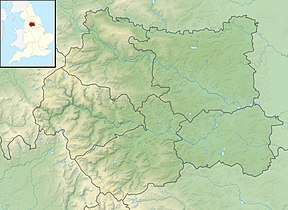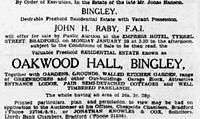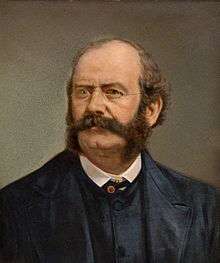Oakwood Hall
| Oakwood Hall | |
|---|---|
|
Oakwood Hall | |
| Type | House |
| Location | Bingley, West Yorkshire |
| Coordinates | 53°51′35″N 1°49′56″W / 53.8597°N 1.8323°WCoordinates: 53°51′35″N 1°49′56″W / 53.8597°N 1.8323°W |
| Built | C.1864 |
| Architect | George Knowles & William Wilcox, William Burges & William Morris & Edward Burne-Jones |
| Architectural style(s) | Victorian |
| Governing body | Privately owned |
Listed Building – Grade II | |
| Official name: Oakwood Hall, Bingley | |
| Designated | 6 November 1973 |
| Reference no. | 337957 |
 Location of Oakwood Hall in West Yorkshire | |
Oakwood Hall, Bingley, West Yorkshire is a 19th-century mansion with substantial interior fittings by the Victorian architect William Burges. The hall was constructed in 1864 by Knowles and Wilcox of Bradford for Thomas Garnett, a prosperous textile merchant. The style is "conventionally dour Gothic"[1]
Garnett had the interiors designed by Burges, who contributed a fireplace, and by Morris & Co., for whom Edward Burne-Jones created the stained glass St. George in the staircase window,[2] whilst Morris himself has been credited with the surrounding images of The Four Seasons.
The Hall is a Grade II Listed Building as at 6 November 1973[3] and is now a hotel.
The Garnett family

Thomas Garnett (1833-1916) who built Oakwood Hall in 1864 was born in 1832 in Otley. His father was Peter Garnett who owned the large Wharfeside Paper Mill in the town.[4] In the 1850s he went into partnership with John Lawson Gillies to form the firm called Gillies Garnett and Co. They were cloth merchants and silk dyers. When Gillies died in 1879 Thomas became the sole owner of the company.
In 1862 he married Fanny Riley (1843-1916) who was the daughter of Joshua Healey Riley, a company owner in the textile business. Soon after he commissioned architects “Knowles and Wilcox” to build Oakwood Hall. William Morris and William Burges were employed for the interior fittings of his new family home. William Morris[5] is attributed with the design of the stained glass windows at the top of the stairs on the first floor landing above the entrance. These show St George flanked by female figures of the Four Seasons as well as depicting Chaucer flanked by the heads of four female Chaucerian Heroines.[6] These windows have been described as “some of the finest early stained glass by Morris and Co. that has yet been discovered.”[7]
The couple had six children. Thomas continued to manage his textile firm until about 1900. He also became a Director of the Bradford Banking Company and of the Hull and Barnsley Railway Company.[8] His wife Fanny died 30 March 1916 and only a few days after her burial Thomas died. Their youngest son Harold Addison Garnett lived in the house for several years and then in about 1920 it was sold to the Hanson family.
The Hanson family

Jonas Hanson (1869-1951) bought Oakwood Hall in about 1920. His story was amazing as he started life in very humble circumstances as a worker in a textile mill. The 1891 Census shows that he is employed as a “weaving overlocker”. He learnt the complexities of the textile industry and in 1903 foundered one of the largest cloth companies in Bradford called Parkland Manufacturing Company[9] which still exists today.
He was born in 1869 in Silsden, Yorkshire. His father Joshua Smith Hanson was a canal worker. In 1897 he married Sarah Jane Kay and the couple had three sons. He was a keen gardener and became President of the Bingley and District Allotment Association.[10] He was also President of the Bingley Building Society for many years and of the Keighley Golf Club. He was President of the Shipley Division of the Conservative Club and held numerous garden parties for the Club at Oakwood Hall.
He died in 1951 at the age of 82 and in the following year his sons sold Oakwood Hall. The sale notice for the property is shown. It was bought by a company who made extensive additions and opened the property as the Oakwood Hall Country Club. This Club operated until about 1980 and then became a hotel.
Notes
- ↑ The Buildings of England: Yorkshire: West Riding, page 616
- ↑ William Burges and the High Victorian Dream, page 301
- ↑ British Listed Buildings online: http://britishlistedbuildings.co.uk/en-337957-oakwood-hall-bingley
- ↑ UK Paper Mills Online History Project website. Online reference
- ↑ Banham, Joanna 1984 “William Morris and the Middle Ages”. Online reference
- ↑ Bingley Hub website. Online reference
- ↑ Aho, G 1985 “William Morris, A Reference Guide”. Online reference
- ↑ Leeds Mercury - Tuesday 04 April 1916, p. 4.
- ↑ Yorkshire Post and Leeds Intelligencer - Wednesday 08 August 1951, p. 5.
- ↑ Shipley Times and Express - Friday 09 September 1921, p. 3.
References
- Pevsner, Nikolaus and Radcliffe, Enid, The Buildings of England: Yorkshire, West Riding (1967) Penguin Books
- Mordaunt-Crook, J William Burges and the High Victorian Dream (1981) John Murray
